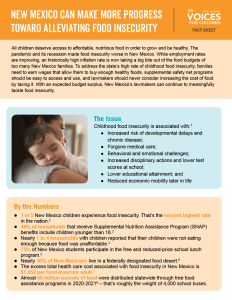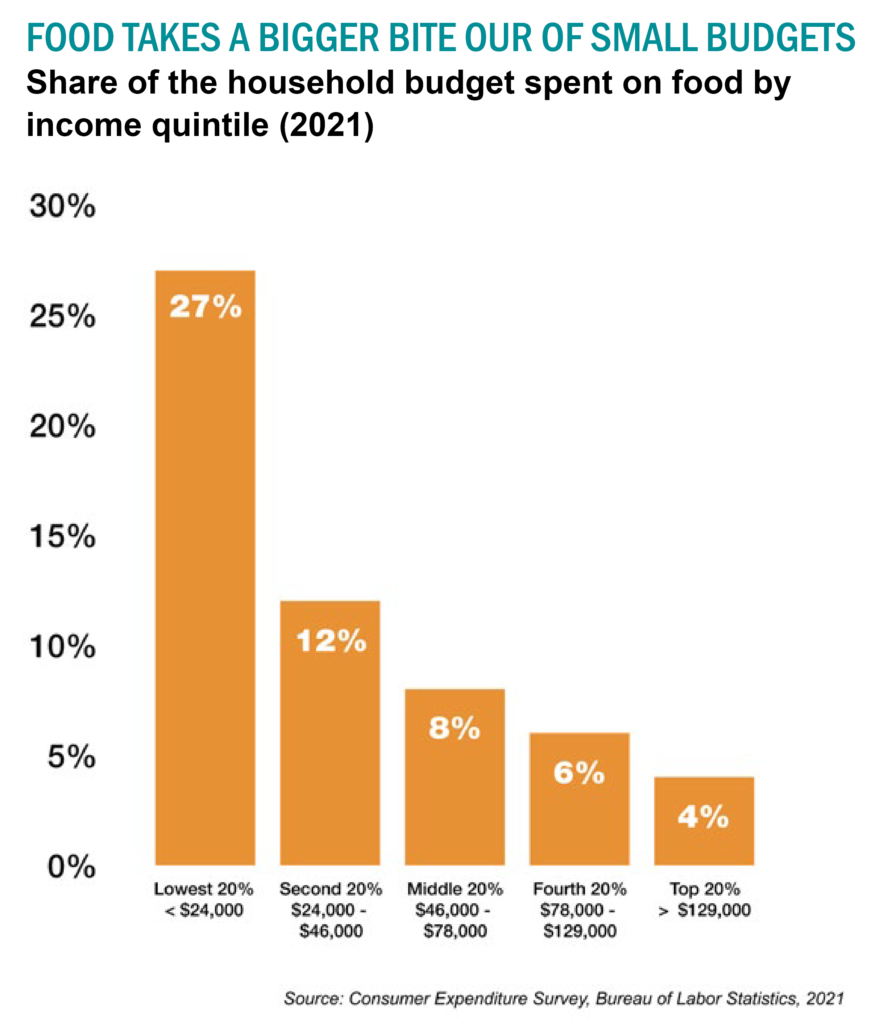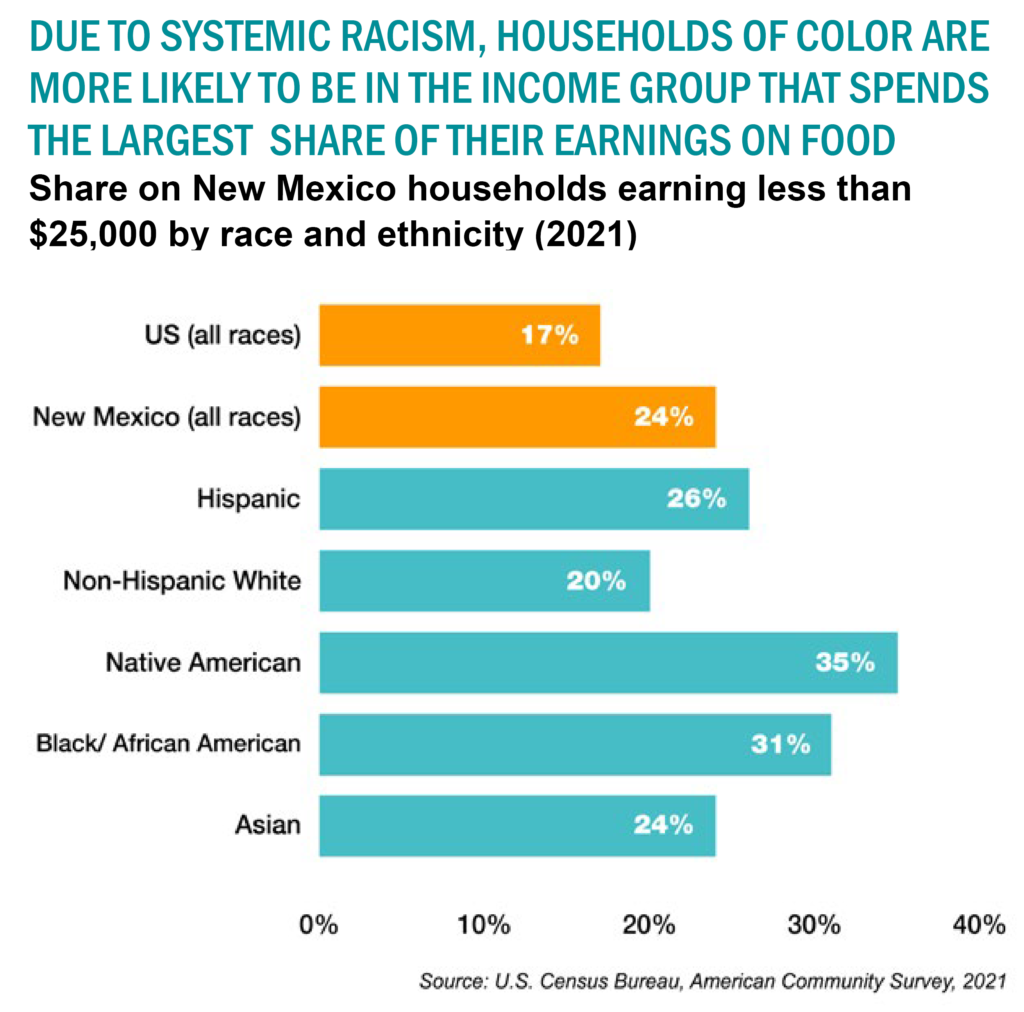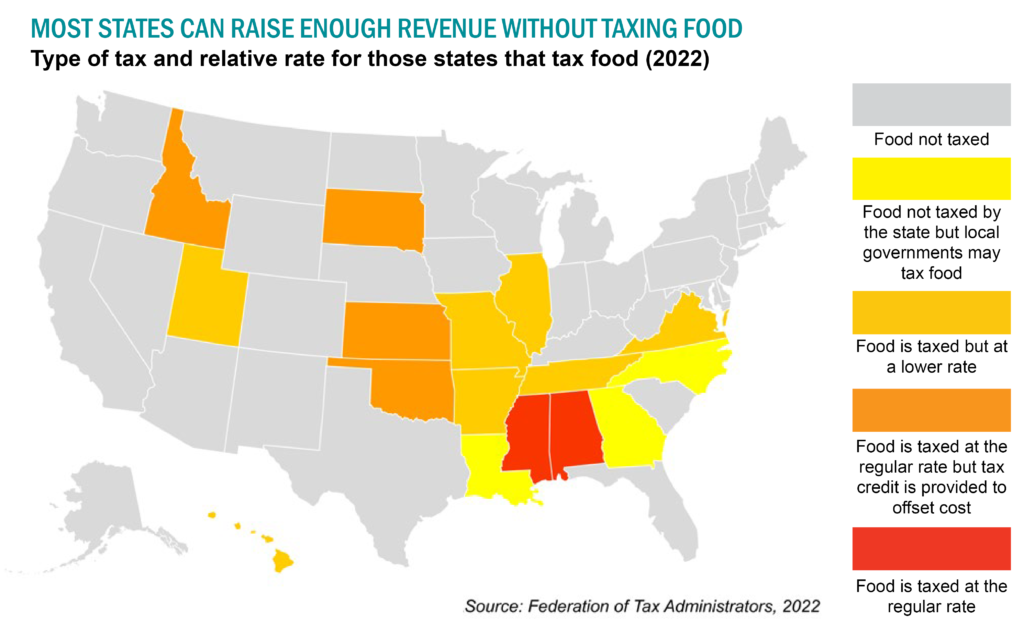 Download this fact sheet (Dec. 2022; 4 pages; pdf)
Download this fact sheet (Dec. 2022; 4 pages; pdf)
All children deserve access to affordable, nutritious food in order to grow and be healthy. The pandemic and its recession made food insecurity worse in New Mexico. While employment rates are improving, an historically high inflation rate is now taking a big bite out of the food budgets of too many New Mexico families. To address the state’s high rate of childhood food insecurity, families need to earn wages that allow them to buy enough healthy foods, supplemental safety net programs should be easy to access and use, and lawmakers should never consider increasing the cost of food by taxing it. With an expected budget surplus, New Mexico’s lawmakers can continue to meaningfully tackle food insecurity.
The Issue
Childhood food insecurity is associated with:[1]
- Increased risk of developmental delays and chronic disease;
- Forgone medical care;
- Behavioral and emotional challenges;
- Increased disciplinary actions and lower test scores at school;
- Lower educational attainment; and
- Reduced economic mobility later in life
By the Numbers
- 1 in 5 New Mexico children experience food insecurity. That’s the second highest rate in the nation.[2]
- 49% of households that receive Supplemental Nutrition Assistance Program (SNAP) benefits include children younger than 18.[3]
- Nearly 1 in 4 households with children reported that their children were not eating enough because food was unaffordable.[4]
- 75% of New Mexico students participate in the free and reduced-price school lunch program.[5]
- Nearly 30% of New Mexicans live in a federally designated food desert.[6]
- The excess total health care cost associated with food insecurity in New Mexico is $1,452 per food-insecure adult.[7]
- Almost 60 million pounds of food were distributed statewide through free food assistance programs in 2020-2021[8] – that’s roughly the weight of 4,000 school buses.



New Mexico lawmakers have made progress in addressing food insecurity by:
- Creating a hunger taskforce to develop recommended solutions;
- Funding Breakfast After the Bell programs in schools to make sure kids have time to access breakfast at school;
- Eliminating co-pays for all students receiving reduced-price school meals;
- Increasing, extending, and reducing barriers for accessing food security benefits during the pandemic—including in SNAP, school meal, and Pandemic Electronic Benefit Transfer (P-EBT) programs; and
- Making an historic investment in the state’s comprehensive Food Initiative to strengthen food systems, improve health through nutrition, and support hunger relief programs.
Policy Recommendations
- Support the recommended change to the federal WIC food package to increase the cash value benefit to help families buy more fruits and vegetables.
- Oppose changes in food assistance programs (like SNAP and WIC) that would limit food purchasing options for families and have a disproportionate impact on communities of color, particularly those living in food deserts
- Support legislation for Healthy School Meals for All to pair healthy meal quality incentives with universal free meals so all students can access nutritious meals at school.
- Fully fund the state Food Initiative to improve local food systems and reduce food insecurity.
- Restore exemptions to TANF work requirements, which were put in place by state law.
- Increase TANF cash benefits to help families meet basic needs.
- Expand the state’s General Assistance Program (GAP) to provide economic relief to families.
- Support two-generation approaches and ensure better coordination between programs providing health, education, housing, and food services for both parents and children.
- Increase the new state Child Tax Credit.
- Do not tax food. Instead, enact a more progressive income tax system so corporations and higher-income earners bear greater responsibility for funding our state.
[1] Think Babies State Factsheets, FRAC, 2019
[2] Map the Meal Gap, Feeding America, 2020
[3] American Community Survey, Census Bureau, table S2201, 2016-2020
[4] New Mexico indicators, KIDS COUNT Data Center, 2022
[5] Free and Reduced Lunch Eligibility Report, NM Public Education Department, SY2021-2022
[6] Ending Childhood Food Insecurity in New Mexico, NM Voices for Children, 2021
[7] The Healthcare Costs of Food Insecurity, Feeding America, 2019
[8] Annual Report 2020-2021, Roadrunner Food Bank, 2021
